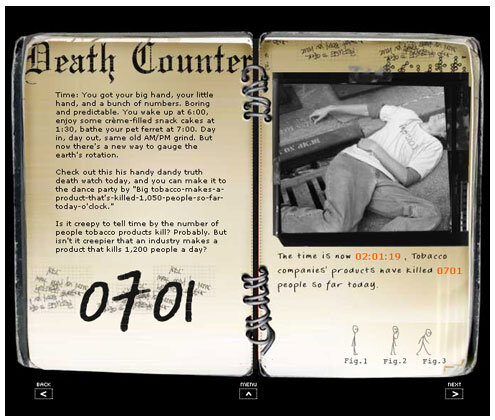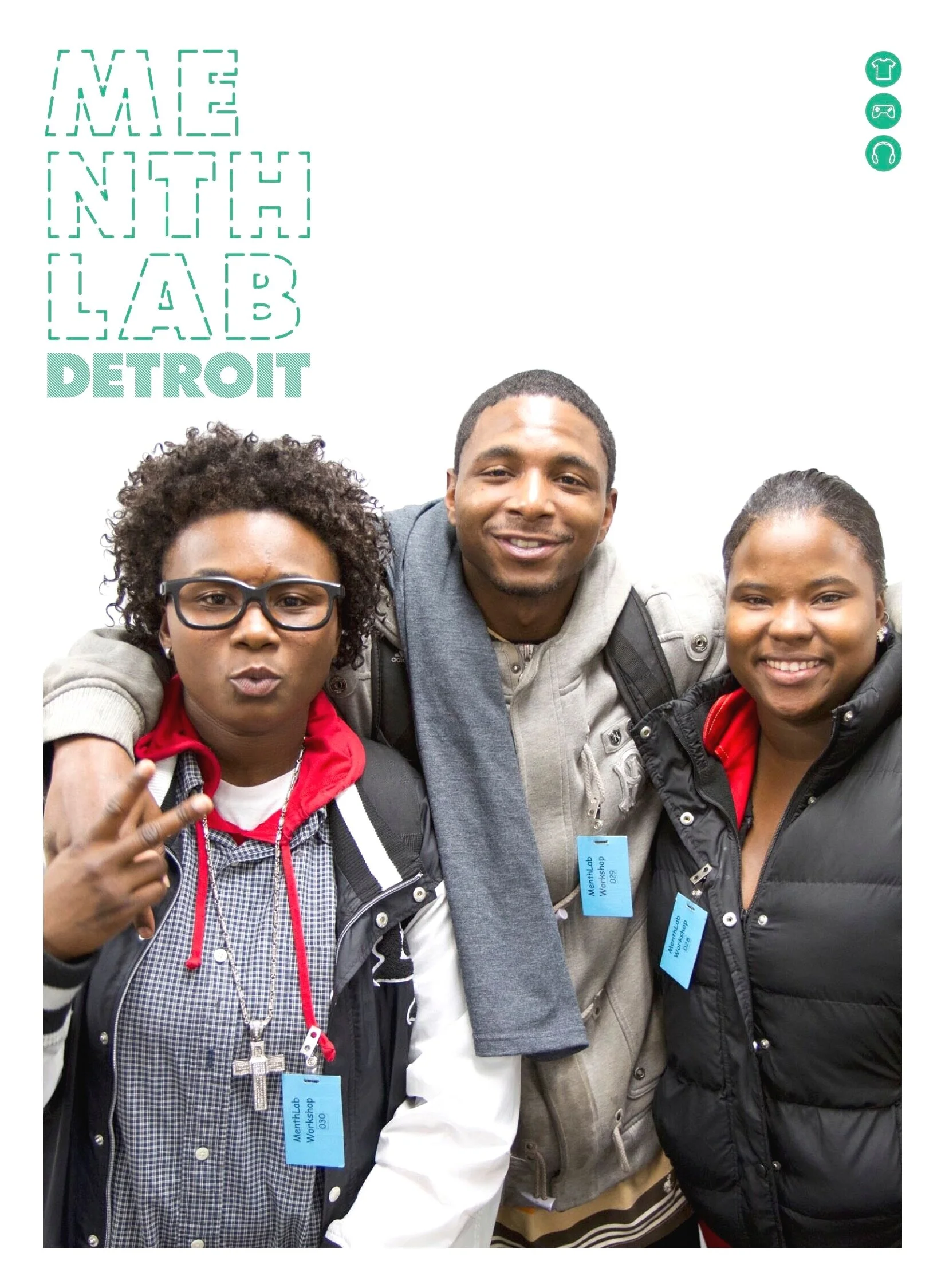
Building an effective national tobacco awareness brand for teens.
The truth® campaign was launched in 2000 to lower the uptake of teen smoking in the US. The campaign was funded by the landmark Master Settlement Agreement between 46 states and the nation's four largest tobacco companies. Our Client’s mission was to "build a world where young people can reject tobacco and anyone can quit."
A growing body of research has confirmed the efficacy of the truth® campaign in changing teens' attitudes and behaviors toward smoking. A study published in the May 2009 issue of the American Journal of Preventive Medicine (AJPM) found that truth® was directly responsible for keeping 450,000 teens from starting to smoke during its first four years, from 2000 to 2004. A second paper in that same publication found that the campaign not only paid for itself in its first two years but also saved roughly $1.9 billion and possibly up to $5.4 billion in medical care costs to society.
From 2001-2013 I helped guide the brand through a period of rapid change, contributing to the creative effort and managing how the campaign was dispersed across an ever-evolving media landscape. I led highly-skilled cross-functional agency teams, in partnership with both the Client and Crispin Porter Bogusky, while collaborating with numerous external media organizations and production companies. The most interesting aspect of working on this brand over a long period of time was figuring out how to continuously re-frame a problem to create a narrative that teens found entertaining while informing the public about the Tobacco Industry’s manipulative business practices.
Achievements
truth® has prevented millions of young people from becoming smokers and helped drive down the youth smoking rate from 23% in 2000 to just 3.7% as of 2020.
truth® was named to the Advertising Age top 15 ad campaigns of the 21st Century and won hundreds of creative awards.
I played a role in launching 15 major campaigns across multiple forms of media.
2013 • ugly truth
Faced with an apathetic audience and brand awareness numbers down to 28%, truth needed to relaunch. It was no longer enough to expose teens to tobacco facts in an interruptive manner. Young people expected brands to give them a way to express themselves. So, we broke through by asking teens to decide which is the single worst fact about Big Tobacco. The campaign generated a 20 percentage-point increase in brand awareness and around 70% of 13-17 year olds said that the ads made them feel more negatively towards Big Tobacco.
Viewers decided "What's the ugliest truth?", cast their votes over social media as to which fact resonates with them more. In addition, there were substantial media integrations with Adult Swim, VH1's "Best Week Ever", TeenNick's Degrassi, MTV's Girl Code.
2012 • Flavor Monsters
Legislation passed in 2009 outlawed the sale of flavored cigarettes, reasoning that tobacco companies produced such items specifically to hook kids. But the law doesn't concern non-cigarette tobacco products, over 45 flavors of which remain on the market. So we created a game called, Flavor Monsters to reveal how the tobacco industry was getting around the rule.
In 2011, the CDC awarded a grant to the truth® campaign to develop a mobile game to reach youth with an anti-tobacco message. The game launched in August 2012, was developed for iOS (iPhone, iPad and iPod Touch) and Google Play (Android) platforms. The story transports users into a not-too-distant future where “flavor monsters” are attacking Earth. To successfully complete each level of the game, players must fight off a vast wave of 1,200 Flavor Monsters. This number is showcased to highlight the fact that 1,200 people die each day in the U.S. from tobacco-related diseases. By designing the “flavor monsters” as life-threatening attackers, players develop an understanding of the deadly nature of tobacco products. Characters “Honey Buzzer” and “Strawberry Brute” were based on the candy-like additives in existing flavored tobacco products.
To promote the game, truth® launched its first gaming tour which included a team of young adult truth ambassadors talking about tobacco and the game at key popular culture/gaming events across the country. A “45 Flavors” installation was created to transport attendees at these events to the Flavor Monsters world, in order to learn more about the monsters and demo the game. Visitors could see displays about tobacco ingredients, get their picture taken with a flavor monster, play Flavor Monsters on IPads, get Flavor Monsters related toys and gear, and take part in a virtual video simulation where it appeared participants were part of the actual Flavor Monsters game. Tour stops included: Gen Con in Indianapolis, Indiana; Dragon*Con in Atlanta, Georgia; and New York Comic Con in New York City, a show that attracts more than 100,000 visitors.
2011 • Night of the Gummies
In 1997, a Big Tobacco executive said under oath that he believed gummy bears were addictive like cigarettes. So to call attention to this ridiculous analogy, we created the free mobile game, Night of the Gummies. In it, users are challenged to protect their house from a bunch of - well, evil gummy bears. The game was available on both the iOS and Android platform and to date has over 400,000 downloads. The game was promoted online and in cinemas.
MenthLab
In October 2011, MenthLab united 45 designers, health experts, entertainers, entrepreneurs, and community activists in Detroit for a 5 day Future Blitz of creative immersion designed to address the scourge of menthol cigarettes in urban communities.
Each day resulted in the creation of music, fashion, and games addressing the Blitz challenge of disrupting the tobacco marketing cycle and reaching vulnerable teen markets with the truth about tobacco and menthol. From the Blitz, a portfolio of 14 little bets emerged that could disrupt menthol’s attack on young African Americans.
This event was my first experience participating in a multi-day design thinking workshop, starting with empathy and ending by collaborating back at the agency with a local team of Detroit musicians and artists led by Mike Ellison to try and launch a Detroit-specific version of the truth® tour.
2010 • Shards O’Glass
Two new TV spots and a refreshed website complete with games resurrected the theme of the 2004 campaign, highlighting the continued irony of tobacco companies producing a dangerous product. This featured a fictitious company that manufactures freeze pops with glass shards in them, a dangerous product analogous to cigarettes. In one spot, the Corporate Executive proudly shares a new tablet product called, Spheres. And a few weeks later, a second spot was released where the Executive realized that “some of our products are addictive and deadly when used correctly” and is calling for an immediate recall of all their products. They’re shutting down the factories “until we can provide consumers with a safer line of glass-filled treats.”
The “Kiss My Glass” web game had over 800,000 plays.
2009 • Do You Have What It Takes to be a Tobacco Exec?
Featured an actor posing as a corporate recruiter asking real-life job-seekers whether they “have what it takes” to be an executive for Big Tobacco. The website featured an series of tests (games) so that users could see if they too had what it takes!
In addition to being the integrated creative director, I directed the video shoot for the digital recruiting experience.
2009 • Big Tobacco Disease
90% of lung cancer comes from Big Tobacco’s products, so in the Summer of 2009 we petitioned to rename it Big Tobacco Disease (BTD). We collected over 90,000 signatures from kids through online tools and in person sign our "BTD petition t-shirts" at the Vans Warped Tour. While the medical profession may not recognize the term "Big Tobacco Disease", those 90,000 kids did.
truth tour
Every summer, orange truth trucks travel across the nation stopping at some of the biggest hot spots like the Vans Warped Tour, Tony Hawk’s Birdhouse, Six Flags, and gaming events like Comic Con, Gen Con, and Dragon Con. The truth event facilitators are known as “Tour Riders”, employees who are typically in their 20s and travel with the tour. Tour Riders are able to connect with over 700,000 teens at popular summer events every year. It's a paid, highly competitive position — Legacy receives upwards of 1,000 applications for 14 positions and hires people based partly on their passion for smoking prevention, as determined by videos submitted with their applications. As fellow youths, tour riders can easily engage young people one-on-one; these interactions between tour riders and visitors as an important success story for truth. Our job at the agency was to refresh the tool kit for tour riders with games, free handouts like clothing, and thematic staging and also create the digital assets that drove the public to these events through social media and ticket contests.
2008 • Sunnyside
Sure, truth has been tough on Big Tobacco. And for good reason: they make a product that kills over 1,200 people a day, so someone needs to say something. But after all these years, we thought we'd give Big T a break and look on the sunnier side of things for once. Like, 1 of every 3 youths who smoke will eventually die from it, that means 2 live! See how easy that is? Visitors to thetruth.com were treated to the Key-tar Slayer game, new musical videos, and a singing unicorn from New York City.
2007 • Whudafxup
The tobacco industry makes a product that kills about 1,200 people every day. What's crazier than that? Well, for starters, they've been manufacturing this product for over a hundred years now. And they continue to do so even after the landmark Master Settlement Agreement forced them to pony up the largest monetary settlement in history. It seems ridiculous, right? Well, it is. And in defending their business, the tobacco industry says the darnedest things. Things that make you want to ask "whudafxup?" And through the investigative work of Derrick Beckles, that's what this campaign aimed to find out.
This was a two-year-long, fully integrated campaign that included tv, radio, print, the tour, and a digital experience that included an artist documentary, games, ringtones and social media.
2006 • infect
Infect truth was a campaign that empowered kids with knowledge about the tobacco industry and encouraged active peer-to-peer participation. We made a lower budget work harder by employing an innovative web strategy that fostered deeper engagements than in previous campaigns. The website was at the center of the campaign and our team designed over 70 pieces of sharable creative that users could share with their friends. An infection tracker on the homepage showed truth as a growth on the side of Big Tobacco office building, that grew bigger with each share. This campaign marks the milestone where the brand was able to build dynamic profile pages on core social networking sites (if you remember MySpace, Hi5, Piczo, Bebo and Xanga) in order to spread it's message. This resulted in 2,146,000 site visits, 154,259 infection emails sent and 25,800 new truth friends.


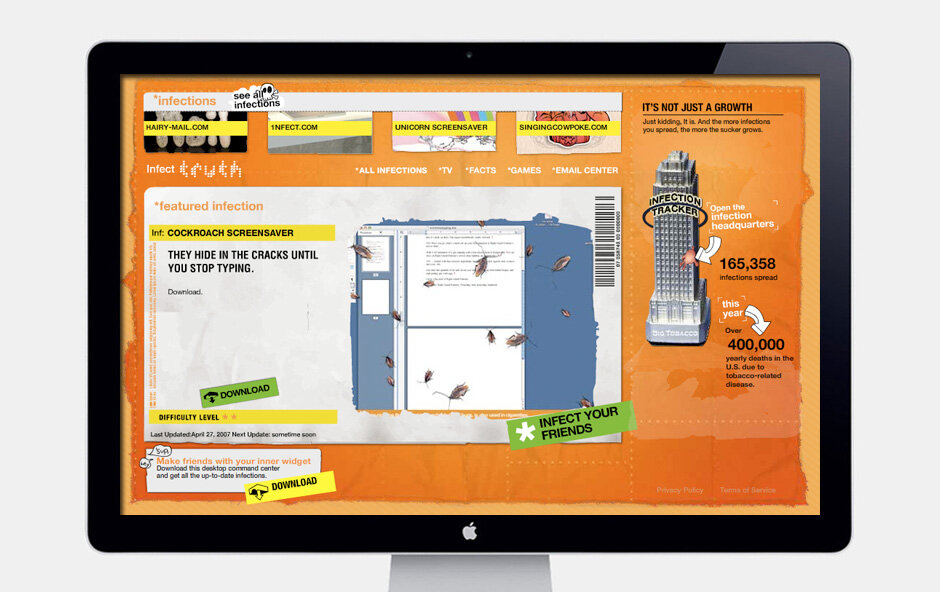
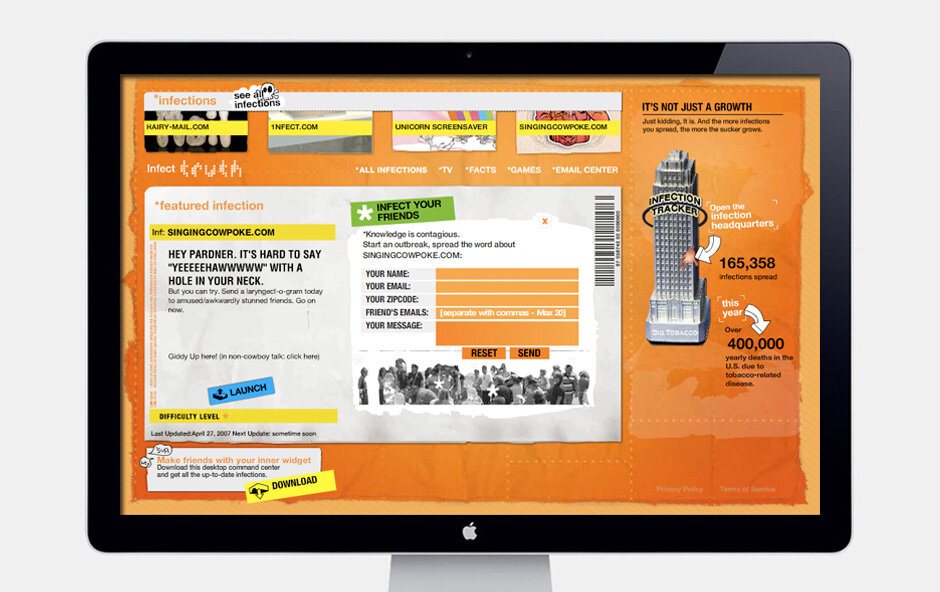

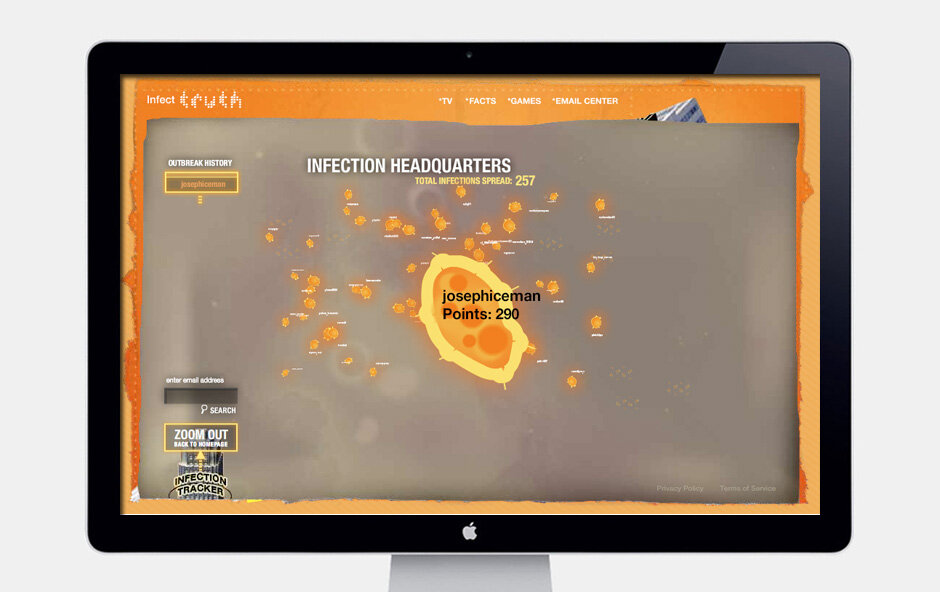

2006 • Hairy Mail
Hairy-mail is a web-based back-hair messaging system. Like the TV, it reveals that one of the chemicals in cigarettes -- sodium hydroxide -- is also found in hair-removal products. You can write a message on a hairy man’s back and send it to friends e-card style. This was the most popular piece from the infect campaign with over 300,000 hairy-mails sent.
In the early days of truth®, content on the internet lived where the creators put it. YouTube didn’t exist until 2005. So, there was a lot of artistic effort and novel interaction design that laid the foundation for the digital home of this campaign.
2005 • Fair Enough
Fair Enough was the world’s first 60-second sitcom. We took the copy for the scripts straight from the files of Big Tobacco. They wrote it down; we just acted it out. Hilarious, yet really disheartening when you stop and think about it. We treated the whole campaign like the launch of a new TV show. Episodes were reviewed by entertainment writers. Outdoor and print promoted the program, but included facts about Big Tobacco. There was even a spin-off comic strip.
I directed the cast in a photo shoot that I used to create the website and the images also appeared in print. Online, we featured the actual tobacco documents used to create each episode. The documents were placed next to the corresponding videos so viewers could see that the "scripts" actually came from big tobacco and not us. We created a hilarious series of satirical games featuring tobacco executive characters eating their words.


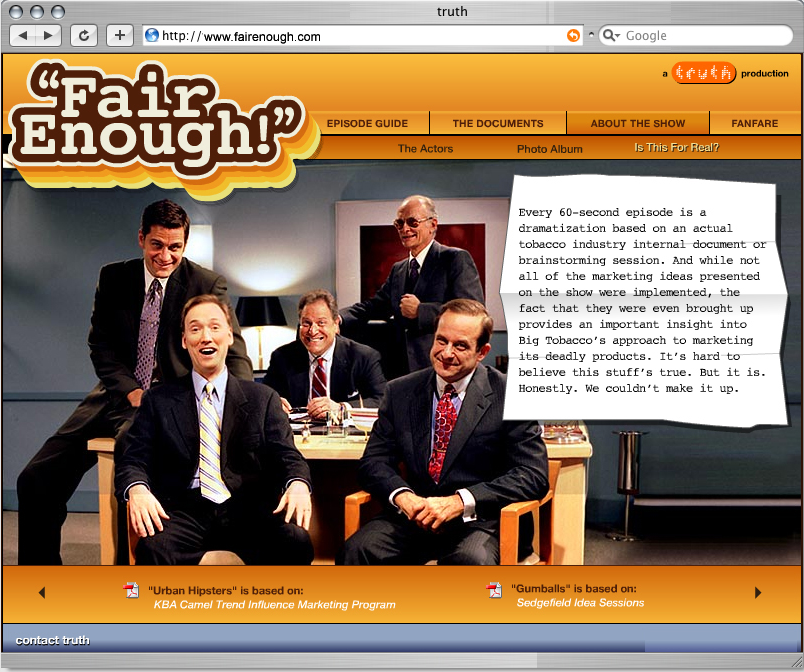
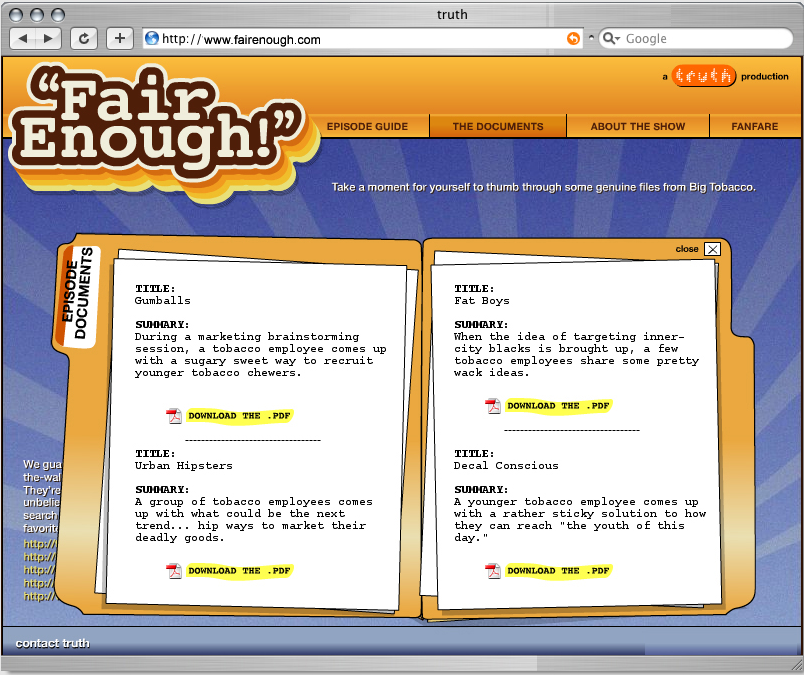


2005 • truth found
Big Tobacco's reach extends far beyond their corporate headquarters and isn't limited to internal documents they've produced. Every decision they make, everything they put in their products, and the ideas they come up with affect people's lives. With 'truth found' a big orange arrow is pointed at some of the people and places affected by Big Tobacco.
Our websites during this time period took a “zine” format to embody the self-published work of an underdog team of activists.
2004 • seek truth
"Seek Truth" uses Q&A format to encourage teens to seek out the truth behind cigarette companies’ marketing claims. The TV set the stage for a Q&A campaign on doorstep of big tobacco company buildings. The website was the digital home base for the campaign, reinforcing that narrative that by questioning authority is often how we get to the truth. This site housed the spots, a section for users to respond to manipulative statements made by executives, posters, wallpaper, games, and fact database.



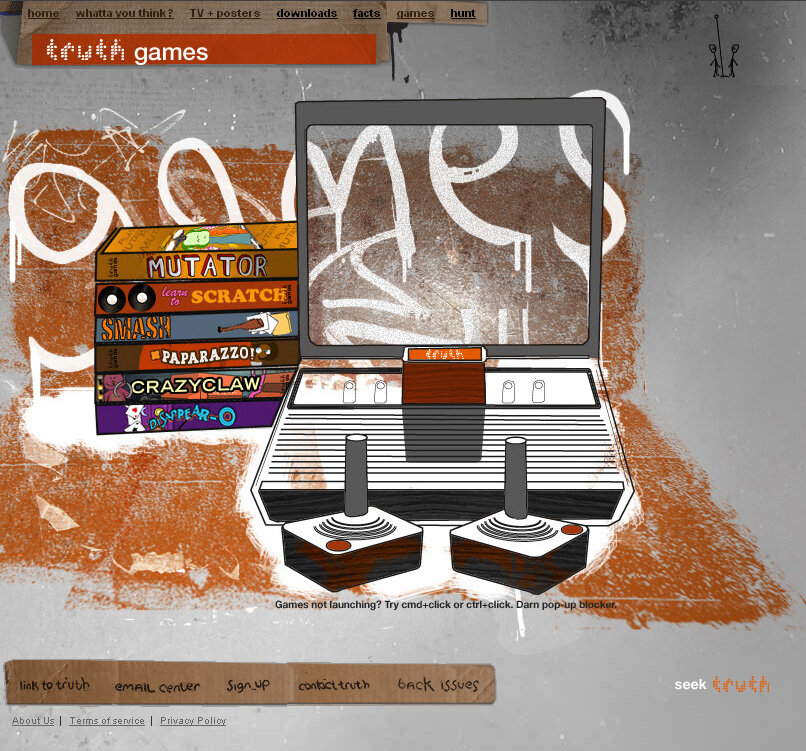

2004 • connect
The connect-truth campaign was created to link together pieces of information to reveal the larger picture about the effects of smoking and the chain that connects marketing to consumer illnesses to death. The concept for this website initially presented to my creative colleagues via spreadsheet, which they didn’t really appreciate until awards season came around.
2002 & 2003 • Crazyworld
This campaign showed teens how tobacco companies play by a different set of rules than other companies. Teens have a sharp sense of right and wrong, and what they believe to be fair or unfair. This campaign set out to show young people that this industry operates under a different, and unfair, set of rules. While many companies recall products at the first sign of danger to a consumer, the tobacco industry makes a product that kills 1,200 of its customers every day. Welcome to Crazyworld. These websites were a collection of games, video content, facts and interactive experiences aimed to engage users who likely landed here after seeing a TV commercial or interacting with truth on tour.










2002 • truth Behind the Curtain
This campaign revealed information from some of the secret documents that became public since tobacco execs were called before Congress in 1994. Each of the three TV spots opens with the words “truth behind the curtain” lettered over a large orange curtain, which is later flung open to reveal a new, horrifying truth about the tobacco industry. The "Project SCUM" tv spot illuminates an outrageous and dehumanizing corporate document that my friend Chris Edwards helped to make massively public by writing the script for this commercial. My role was to create the website that received the traffic driven from TV.



2002 • 1200
Operation Drop Dead Day website captured a gritty behind the scenes look into the iconic tv spot where 1200 kids dropped dead outside a major tobacco company.


